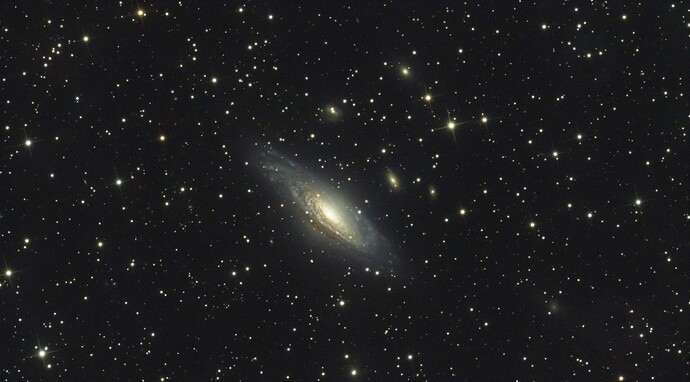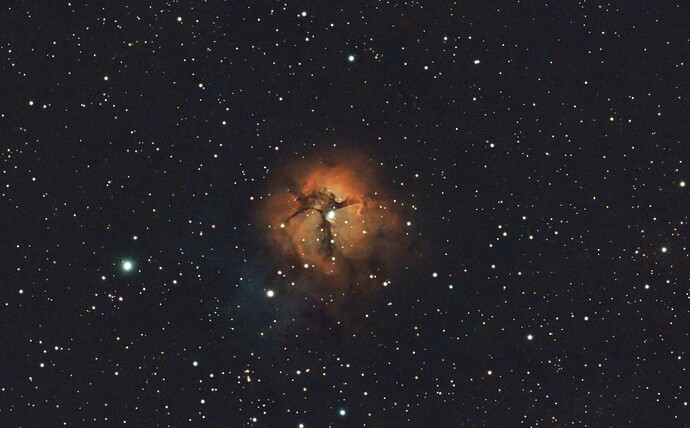![]() I hope his Dad does better in future! It’s a small world, my mother and one of my brothers and his family lives in Tutbury.
I hope his Dad does better in future! It’s a small world, my mother and one of my brothers and his family lives in Tutbury.
Last night the Moon was pretty bright, but I wanted to test out a new focuser for my scope. The new focuser is much more robust than the stock one that came with the scope. I’m very happy that it seems to have eliminated one of the big issues I was having where the stars at the edge of an image were distorted. This was caused by the weight of the camera, filter drawer and focal reducer.
So, this is a test shot of M51 - The Whirlpool Galaxy, in less than optimal conditions…
I will revisit this target on a better night.
Last night I collected 6 hours of data for M51 under moonless skies. You can see that the extra time, and better conditions have made a difference to the detail in the fainter parts of the galaxy. I still need to play with this one a little more as I am not 100% happy with the color. Sometimes it is hard to know when to stop with image processing.
and this one is M63, aka the Sunflower Galaxy… I have always had a hard time processing images of this target, but this one came out reasonably well I think.
Awe inspiring.
I haven’t been able to make my galaxy images ‘pop’ with regard to color, so I bit the bullet and actually followed a tutorial on YouTube. What do you guys think of this verses the original version I posted?
Original:
Reworked:
Looks good to me!
I’m torn. While the original shots are probably closer to what we would see with the ‘naked eye’ I am so used to seeing so many shots that highlight different absortion spectra I’m gravitating (unintended pun) towards the reworked images… They seem to ‘pop’ more?
I prefer the reworked versions too, but I make no claim that they are correctly color balanced. Scientifically speaking, these are little more than pretty pictures.
I love the reworked shots. The previous versions have a kinda greenish-yellow tint that looks a bit weird.
That is insane dude. That looks like a render not something a “hobbyist” astronomer. (And by “hobbyist”…I mean…I know you’ve sunk a lot into your hobby and equipment and skills…but that is just an incredible photo to see from some non-government funded institution…)
I’m glad you like them. I still feel like I have a lot to learn, especially when it comes to the image processing side of things… but I’m definitely improving. After taking a 12 year break from doing any serious imaging, getting back into it this past 8 months has been a very enjoyable challenge, but overall I think it is a lot easier now than it was just a few years ago. The equipment is better and easier to use and the software for image acquisition and processing come a long way. I would still like to have a backyard observatory like I had when I lived in Ohio, but that will have to wait awhile… a new roof on the house and a solar power installation is going to dent the discretionary funds for a bit ![]() .
.
Some more data from last year, reprocessed now that I know a little more.
NGC7331 in the constellation Pegasus.
Goodness the vastness of space is just…incomprehensible.
We just don’t matter. Or…
We’re just matter.
As Douglas Adams said in the Hitchhiker’s Guide to the Galaxy….
“Space is big. You just won’t believe how vastly, hugely, mind-bogglingly big it is. I mean, you may think it’s a long way down the road to the chemist’s, but that’s just peanuts to space.”
And then I think about the virtually microscopic dots of matter scattered in all that vast space, and how the majority of them are essentially… desolate nothing.
Fantastic work on the astrophotos @PaulRix







